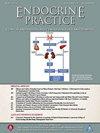Continuous Glucose Monitoring in Hospitalized Patients With Type 2 Diabetes: A Step Forward in Inpatient Glycemic Control
IF 3.7
3区 医学
Q2 ENDOCRINOLOGY & METABOLISM
引用次数: 0
Abstract
Objective
To determine the effect and safety of continuous glucose monitoring (CGM) use in glycemic control compared to standard approach in hospitalized patients with type 2 diabetes.
Methods
This was a pilot randomized controlled clinical trial that enrolled 37 hospitalized patients with type 2 diabetes admitted in medical and surgical wards. All patients used CGM (Abbott FreeStyle2 or FreeStyle3) and concomitantly 6-point point of care glucose. In group A (n = 19), daily CGM profiles, alarms, and trend arrows were considered for glycemic therapeutic decisions and in group B (n = 18) were based on point of care glucose. Primary outcomes included the difference in time in range 70-180 mg/dL, hospital glycemia risk index, time below range measured as the percentage below 70 mg/dL and below 54 mg/dL, and time above range measured as the percentage above 180 mg/dL and above 250 mg/dL.
Results
Time in range was higher in group A: 78.26 ± 10.83% vs 67.39 ± 19.13% P = .04. Time above range level 1 in group A: 14.37 ± 8.33% vs group B: 23.28 ± 16.62% P = .04. Asymptomatic hypoglycemic events were more detected by CGM-group (1.65 ± 2.03 vs 0.31 ± 0.60 P = .01). Overall mean absolute relative difference: 14.7%. Diabetes technology society error grid: 69.5% zone A and 29.3% zone B.
Conclusions
The implementation of CGM in hospitals could represent a significant advancement in diabetes management, offering a more comprehensive and dynamic approach to monitoring glucose levels. Further research is needed to explore the long-term impacts of CGM on clinical outcomes and to optimize its integration into hospital protocols.
2型糖尿病住院患者持续血糖监测:住院患者血糖控制的新进展
目的:比较连续血糖监测(CGM)在住院2型糖尿病(T2D)患者血糖控制中的效果和安全性。方法:这是一项随机对照临床试验,纳入内科和外科病房住院的37例T2D患者。所有患者均使用CGM (Abbott FreeStyle2或FreeStyle3)并同时使用6点护理点葡萄糖(POCG)。在A组(n=19)中,考虑每日CGM概况,警报和趋势箭头来决定血糖治疗,在B组(n=18)中,基于POCG。主要结局包括时间范围(TIR) 70-180 mg/dL的差异、医院血糖危险指数(GRI)、低于范围时间(TBR)(低于70 mg/dL和低于54 mg/dL的百分比)以及高于180 mg/dL和高于250 mg/dL的百分比(TAR)。结果:A组TIR为78.26±10.83%比67.39±19.13%,p=0.04。A组TAR 1级:14.37±8.33% vs. B组:23.28±16.62% p=0.04。cgm组无症状低血糖发生率较高(1.65±2.03∶0.31±0.60 p=0.01)。总体MARD: 14.7%。DTS误差格:A区69.5%,b区29.3%。结论:CGM在医院的实施代表了糖尿病管理的重大进步,提供了一种更全面和动态的血糖监测方法。需要进一步的研究来探索CGM对临床结果的长期影响,并优化其与医院方案的整合。
本文章由计算机程序翻译,如有差异,请以英文原文为准。
求助全文
约1分钟内获得全文
求助全文
来源期刊

Endocrine Practice
ENDOCRINOLOGY & METABOLISM-
CiteScore
7.60
自引率
2.40%
发文量
546
审稿时长
41 days
期刊介绍:
Endocrine Practice (ISSN: 1530-891X), a peer-reviewed journal published twelve times a year, is the official journal of the American Association of Clinical Endocrinologists (AACE). The primary mission of Endocrine Practice is to enhance the health care of patients with endocrine diseases through continuing education of practicing endocrinologists.
 求助内容:
求助内容: 应助结果提醒方式:
应助结果提醒方式:


